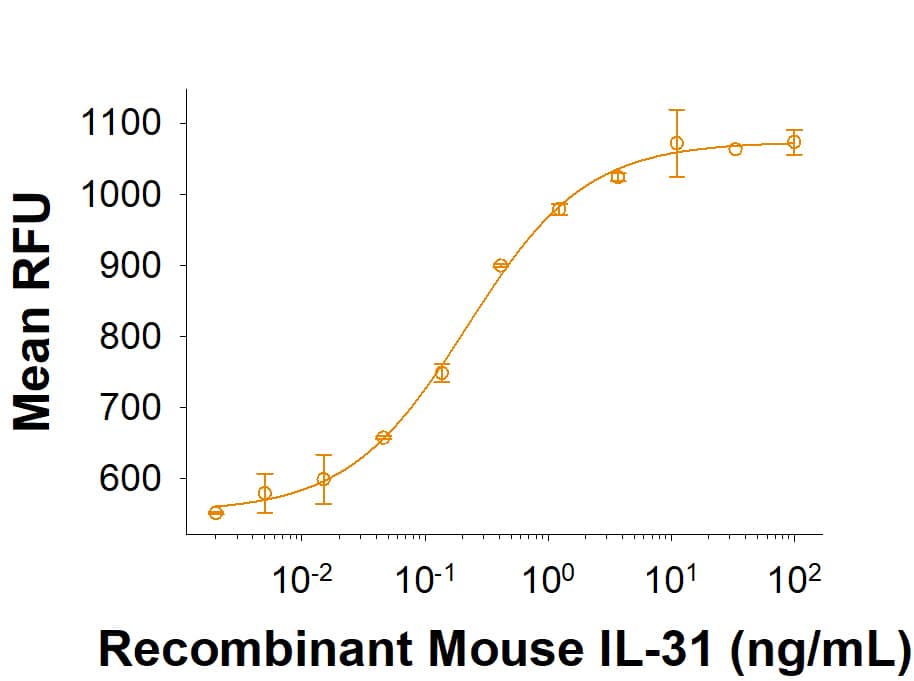Recombinant Mouse IL-31 (Mammalian-expressed) Protein, CF
R&D Systems, part of Bio-Techne | Catalog # 10409-ML

Key Product Details
Product Specifications
Source
Human embryonic kidney cell, HEK293-derived mouse IL-31 protein
Ala31-Cys163
Ala31-Cys163
Purity
>95%, by SDS-PAGE visualized with Silver Staining and quantitative densitometry by Coomassie® Blue Staining.
Endotoxin Level
<0.10 EU per 1 μg of the protein by the LAL method.
N-terminal Sequence Analysis
Ala31
Predicted Molecular Mass
15 kDa
SDS-PAGE
16-25 kDa, under reducing conditions
Activity
Measured by its ability to induce STAT3 reporter activity in HEK293 human embryonic kidney cells transfected with mouse IL-31RA and OSMR beta. The ED50 for this effect is 0.05-0.4 ng/mL.
Scientific Data Images for Recombinant Mouse IL-31 (Mammalian-expressed) Protein, CF
Recombinant Mouse IL-31 (Mammalian-expressed) Protein Bioactivity
Mammalian-expressed Recombinant Mouse IL-31 (Catalog # 10409-ML) induces STAT3 reporter activity in HEK293 human embryonic kidney cells transfected with mouse IL-31RA and OSMR beta. The ED50 for this effect is 0.05-0.4 ng/mL.Recombinant Mouse IL-31 (Mammalian-expressed) Protein SDS-PAGE
2 μg/lane of Recombinant Mouse IL-31 (Mammalian-expressed) Protein (Catalog # 10409-ML) was resolved with SDS-PAGE under reducing (R) and non-reducing (NR) conditions and visualized by Coomassie® Blue staining, showing bands at 16-25 kDa.Formulation, Preparation and Storage
10409-ML
| Formulation | Lyophilized from a 0.2 μm filtered solution in PBS. |
| Reconstitution | Reconstitute at 100 μg/mL in PBS. |
| Shipping | The product is shipped at ambient temperature. Upon receipt, store it immediately at the temperature recommended below. |
| Stability & Storage | Use a manual defrost freezer and avoid repeated freeze-thaw cycles.
|
Background: IL-31
References
- Zhang, Q. et al. (2008) Cytokine Growth Factor Rev. 19:347.
- Venereau, E. et al. (2009) J. Biol. Chem. 285:14955.
- Dillon, S.R. et al. (2004) Nat. Immunol. 5:752.
- Diveu, C. et al. (2004) Eur. Cytokine Netw. 15:291.
- Dreuw, A. et al. (2004) J. Biol. Chem. 279:36112.
- Dieu, C. et al. (2003) J. Biol. Chem. 278:49850.
- Ghilardi, N. et al. (2002) J. Biol. Chem. 277:16831.
- Mosley, B. et al. (1996) J. Biol. Chem. 271:32635.
- Chattopadhyay, S. et al. (2007) J. Biol. Chem. 282:3014.
- Perrigoue, J.G. (2009) J. Immunol. 182:6088.
- Broxmeyer, H.E. et al. (2007) Exp. Hematol. 35(Suppl 1):78.
- Takaoka, A. et al. (2005) Eur. J. Pharmacol. 516:180.
Long Name
Interleukin 31
Alternate Names
IL31
Gene Symbol
IL31
UniProt
Additional IL-31 Products
Product Documents for Recombinant Mouse IL-31 (Mammalian-expressed) Protein, CF
Product Specific Notices for Recombinant Mouse IL-31 (Mammalian-expressed) Protein, CF
For research use only
